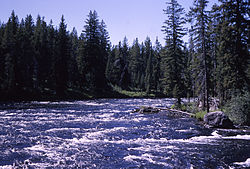| Bechler River | |
|---|---|
 Bechler River | |
 | |
| Physical characteristics | |
| Source | |
| • location | Trischman Knob |
| • coordinates | 44°17′21″N110°53′35″W / 44.28917°N 110.89306°W [1] |
| • elevation | 6,306 feet (1,922 m) [1] |
| Mouth | |
• location | Fall River |
• coordinates | 44°08′54″N110°59′49″W / 44.14833°N 110.99694°W [1] |
| Basin features | |
| Tributaries | |
| • left | Ferris Fork, Littler Fork |
| • right | Boundary Creek, Ouzel Creek, Phillips Fork, Gregg Fork |
The Bechler River is a remote major river flowing southwest entirely within the confines of Yellowstone National Park to its confluence with the Fall River in the southwest section of the park. The river was named by Frank Bradley, a member of the 1872 Hayden Geological Survey for cartographer and explorer Gustavus R. Bechler, the chief surveyor and mapmaker on the survey. Henry Gannett also a member of the survey claimed that Bechler discovered the river, but trapper Osborne Russell explored the area in 1830. [2]
